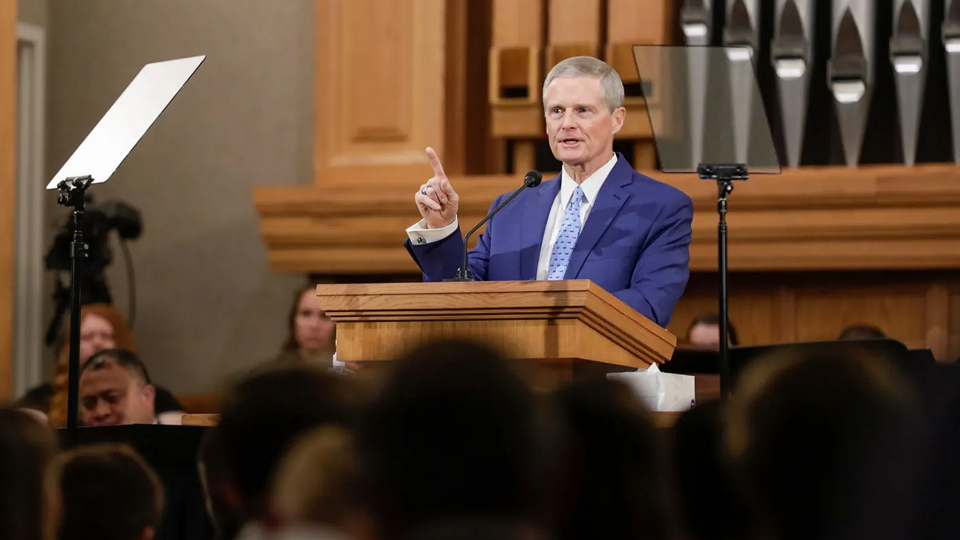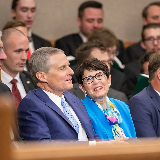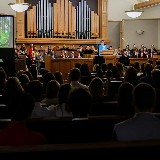| Elder David A. Bednar of the Quorum of the Twelve Apostles speaks a devotional at the Salt Lake Institute of Religion at the University of Utah in Salt Lake City on Sunday, August 28, 2022. Photo by Ben B. Braun, courtesy of Church News. Copyright 2022 Deseret News Publishing Company. | 1 / 7 |
This story appears here courtesy of TheChurchNews.com. It is not for use by other media.
By Scott Taylor, Church News
Under premises such as “seeing is believing,” critics and cynics for millennia have said faith in the Savior Jesus Christ and His coming is “unreasonable.”
For Elder David A. Bednar of the Quorum of the Twelve Apostles, the opposite is true: “I believe it is unreasonable to claim that faith in Jesus Christ is unreasonable,” he said.
In a Sunday, August 28, devotional at the University of Utah Institute of Religion in Salt Lake City, Elder Bednar underscored Satan’s long-standing strategies of deception and spiritual destruction, and he highlighted five fundamental doctrinal truths taught by the Prophet Joseph Smith as support that it is unreasonable to suggest the restoration of the Lord’s gospel and Church in the latter-days as unreasonable.
The five truths “are but a beginning glimpse into the vast scope, depth, breadth and eternal importance of the restored gospel of the Lord Jesus Christ,” said Elder Bednar, who was accompanied by his wife, Sister Susan Bednar.
Her brief message — on having faith in the Lord, faith in oneself, faith in the future, and her witness of her husband’s apostolic calling — served as a fitting precursor to Elder Bednar’s instruction.
The Apostle explained the devotional was “Part 1” of a planned two-devotional series on faith and believing; with Part 2 to be presented in another university devotional later this fall.
Satan’s Strategies of Deception
The Book of Mormon contains valuable lessons about Satan’s strategies of deception and spiritual destruction — tactics used both then and today. Elder Bednar cited exchanges between Korihor and Alma and the example of unbelievers during the time of Samuel the Lamanite.
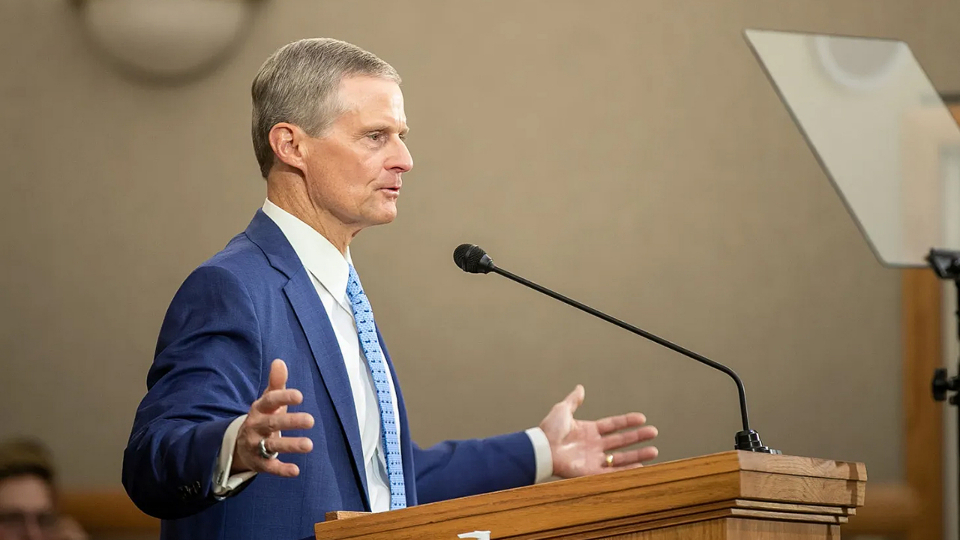
Bednar-UofU-Belief-1
Elder David A. Bednar of the Quorum of the Twelve Apostles speaks a devotional at the Salt Lake Institute of Religion at the University of Utah in Salt Lake City on Sunday, August 28, 2022. Photo by Ben B. Braun, courtesy of Church News.Copyright 2022 Deseret News Publishing Company.
In Alma 30, Korihor the anti-Christ ridiculed the Savior, His Atonement and the spirit of prophecy while demeaning, disparaging and devaluing the faithful and their beliefs. He used statements such as “bound down under a foolish and vain hope,” “foolish traditions,” “a frenzied mind, “derangement of your minds” and “ye cannot know of things which ye do not see.”
“That one simple assertion denigrates any means of knowing other than seeing,” Elder Bednar said. “It falsely sweeps away all historical knowledge, all knowledge obtained through vicarious learning, all individual or collective intuition, all knowledge resulting from cognitive construction, and dismisses the existence of objects or places not personally seen.”
He contrasted that with the teachings of Alma — “faith is not to have a perfect knowledge of things; therefore if ye have faith ye hope for things which are not seen, which are true” (Alma 32:21) — and said that “with Christ-focused faith, believing that which is true but not visible is in fact seeing.”
Added Elder Bednar: “I wholeheartedly and emphatically reject Korihor’s arguments that belief in Jesus Christ and His mortal mission is the result of foolish traditions and frenzied and deranged minds. I testify that we come to know many things through means other than sight, especially spiritual things.”
Coming approximately 70 years after Korihor, Helaman 16 describes the ministry of Samuel the Lamanite just a few years before the Savior’s birth. Elder Bednar pointed out two specific elements of false ideas and subtle deception used then by unbelievers.
First, they discounted prophesied miraculous events by attributing them primarily to guesswork and random chance. “And how exactly did the doubters ‘know’ that many ‘great and marvelous works’ could not come to pass? … Since, according to Korihor, seeing is knowing and because the events had not yet occurred and could not have been seen, the logic among the unbelievers clearly is inconsistent and contradictory.”
Second is the statement “it is not reasonable that such a being as a Christ should come.”
Said Elder Bednar: “Again, I wholeheartedly and emphatically reject the propositions that the believers at the time of Samuel the Lamanite merely ‘guessed right,’ that seeing is the best and only way of knowing, and that it is unreasonable such a being as a Christ should come.
“In fact, I believe it is unreasonable to claim that faith in Jesus Christ is unreasonable.”
5 Key Doctrinal Truths
The basic arguments used by contemporary detractors have not changed much since those times, with unbelievers objecting to the First Vision, translation of the golden plates, modern revelation and more are unreasonable and preposterous.
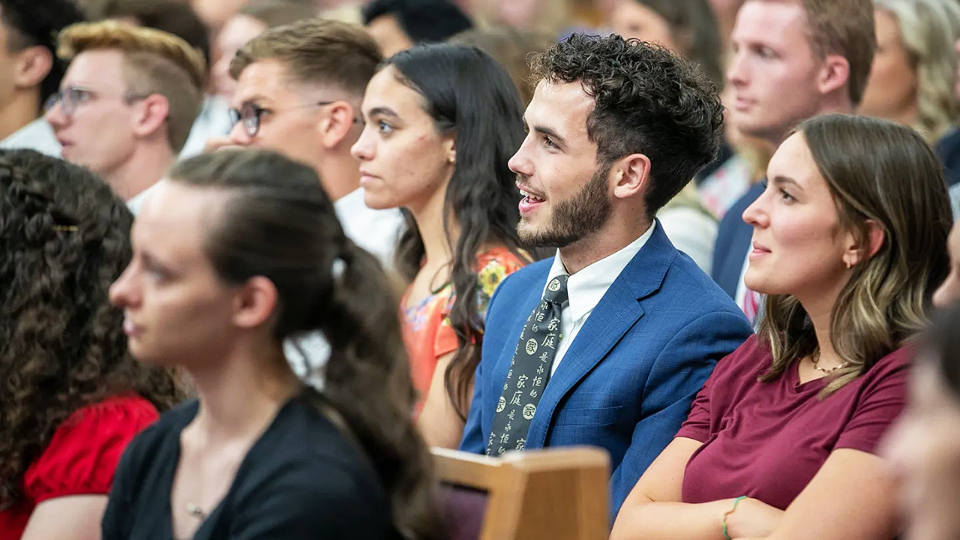
Bednar-UofU-Belief-1
Attendees listen as Elder David A. Bednar speaks at a devotional at the Salt Lake Institute of Religion at the University of Utah in Salt Lake City on Sunday, August 28, 2022. Photo by Ben B. Braun, courtesy of Church News.Copyright 2022 Deseret News Publishing Company.
To support his contention that it is unreasonable to suggest the restoration of the Lord’s gospel and Church in the latter days is unreasonable, Elder Bednar reviewed five key doctrinal truths in the context of Joseph Smith’s early exposure to religious tenets coming from family discussions and various ministers of his day and location.
Elder Bednar invited listeners to draw their own conclusions about whether:
- Seeing is the best and only way of knowing what one knows,
- Joseph Smith was influenced by false traditions,
- Believers have frenzied minds,
- Prophets merely guessed right,
- And the restoration of the Savior’s Gospel and Church is unreasonable.
The five doctrinal truths are:
1. The Nature and Character of the Godhead
In the early 1800s, the Godhead was explained most commonly as one divine “being” appearing in different forms — sometimes as the Father, sometimes as the Son, sometimes as the Holy Spirit.
From the First Vision and beyond, Elder Bednar taught, Joseph Smith learned the attributes, character and perfections of the Godhead; that the Father and the Son are separate and distinct Beings of flesh and bones; that the Holy Ghost is a personage of Spirit; and that Jesus Christ is the literal Son of God in spirit and flesh, having progressed until He became even as the Father.
2. Heavenly Father’s Plan of Salvation
With his brother Alvin having passed away earlier, Joseph and his family were mindful of the day’s teaching that those who died unbaptized or “unchurched” were lost for eternity with no hope for salvation.
As restored through Joseph Smith, the gospel of Jesus Christ declares that all lived as spirit children of God before mortal birth, that Heavenly Father instituted a plan of salvation to allow His children to become like Him, said Elder Bednar, adding that additional learnings include the Father’s plan being presented in a grand council in heaven, His selection of Jesus Christ as our Savior, and the Lord’s invitation for all to come unto Him and receive the blessings of salvation and exaltation.

Bednar-UofU-Belief-1
An attendee listens to Elder David A. Bednar speak at a devotional at the Salt Lake Institute of Religion at the University of Utah in Salt Lake City on Sunday, August 28, 2022. Photo by Ben B. Braun, courtesy of Church News.Copyright 2022 Deseret News Publishing Company.
3. The Importance of Mortality and a physical Body
In the 1800s, some Christians believed that life’s purpose was to determine if one would go to heaven or hell and that physical bodies were prone to sin and limited physical progress.
The restored gospel teaches that mortality is a period of learning, proving and preparing to return to the presence of God, that there are various degrees of eternal glory, that all would receive some degree of glory, and that the physical body is a sacred gift from God allowing one to become more like Him and receive a fulness of joy, Elder Bednar said.
4. The Creation of the Earth and the Fall of Adam and Eve
In Joseph’s time, some Christians believed God created the earth out of nothing, or ex nihilo. They did not believe that a spiritual creation preceded the physical creation. Also, many believed that the fall of Adam and Eve was a tragic error, a disruption of God’s designs and an “original sin” resulting in humans being born into a state of sin.
According to the restored gospel of Jesus Christ, God created all things spiritually before they created temporally, the earth was organized from existing elements that are eternal, and the fall was necessary to bring to pass Heavenly Father’s plan of offering the blessings of eternal life to His children, Elder Bednar said.
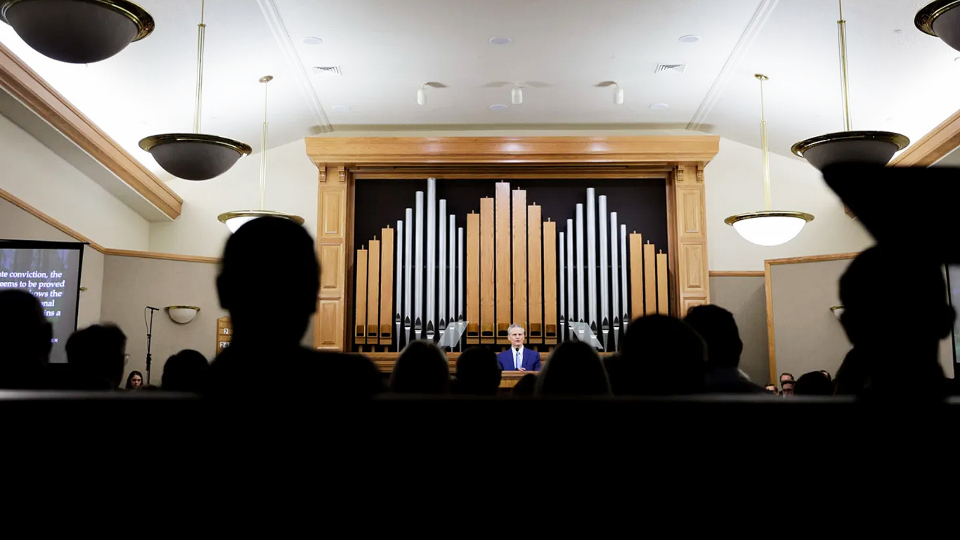
Bednar-UofU-Belief-1
Elder David A. Bednar of the Quorum of the Twelve Apostles speaks a devotional at the Salt Lake Institute of Religion at the University of Utah in Salt Lake City on Sunday, August 28, 2022. Photo by Ben B. Braun, courtesy of Church News.Copyright 2022 Deseret News Publishing Company.
5. The Atonement of Jesus Christ
Understandings and teachings about the redemptive role of Christ and His atoning sacrifice varied at the time of the Prophet Joseph Smith — from Christ having died to rebalance the injustice created by sin, to the Savior standing in as substitute to suffer the penalties of sins or Jesus dying to satisfy God’s wrath and paying for sins in a general way.
The restored gospel, Elder Bednar said, teaches that Old Testament prophets knew of the Savior’s Atonement and exercised faith unto repentance, with the Book of Mormon teaching that man is saved by both the grace of Christ and individual works. “As part of His atoning sacrifice, Jesus Christ suffered for our sins and took upon Himself the pains, sicknesses and infirmities of all mankind so He would know according to the flesh how to succor and strengthen us.”
Invitations, Promise and Testimony
Using phrases from Alma 32, Elder Bednar invited listeners to accept Alma’s invitation to “awake and arouse your faculties” and to “exercise a particle of faith, seeing if the “word” of truth does “begin to swell within your breasts” and “enlarge [your] soul.”
He asked; “Can you feel by the power of the Holy Ghost the truth of these doctrinal foundations which cannot be touched or seen, but which begin to ‘enlighten your understanding’ and ‘increase your faith’?”
Elder Bednar offered a “Part 2” preview, saying it will address additional truths such as the role and importance of priesthood authority and keys; prophets, apostles and revelation; additional latter-day scripture; sacred covenants and ordinances; and holy temples and vicarious work for the dead.
Telling his listeners “if all you know about the gospel of Jesus Christ is what others have told you, you’ll never know enough,” Elder Bednar said one cannot live on borrowed light and emphasized the importance of personal scripture study and learning. “It is important for each of us to have a personal covenant connection with the living Lord Jesus Christ.”
Reason is important and useful; however, it is neither the best nor the only way of knowing, he added. “A witness of truth by the power of the Holy Ghost that we invite into our soul produces a spiritual knowledge, an illumination and a conviction more sure, more powerful and more enduring than can be received through seeing, hearing, touching or rational argument alone.”
The Apostle concluded with his testimony, underscoring the five doctrinal truths he had reviewed.
“The sacred and personal testimony I now declare to you stands independent of any other person and transcends the five physical senses. I witness that God, the Eternal Father, is our Father, and He is the author of the plan of happiness. I further testify and witness that Jesus Christ is the Father’s Only Begotten and Beloved Son; He is our Savior and our Redeemer. His atoning sacrifice is central in and essential to the Father’s plan,” Elder Bednar said.
“I witness that the Father and the Son appeared to the boy Joseph Smith, thus initiating the restoration of the gospel of Jesus Christ in the latter days. And I witness that the restoration is ongoing. The heavens are not closed, and the Savior continues to reveal His mind and will to His servants the prophets. The covenants and ordinances of the gospel yoke us to and with the resurrected and living Lord.”
Copyright 2022 Deseret News Publishing Company.
